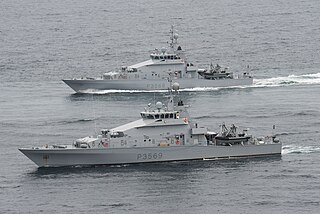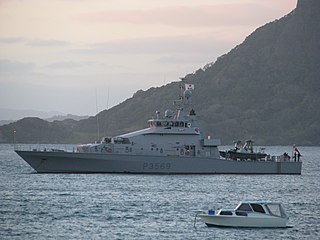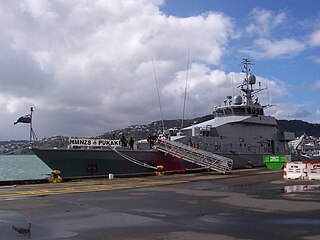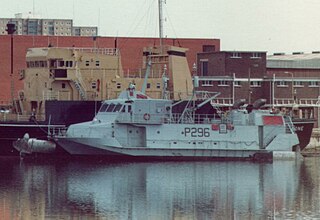
The South African Navy is the naval warfare branch of the South African National Defence Force.
A patrol boat is a relatively small naval vessel generally designed for coastal defence, border protection, immigration law-enforcement, search and rescue duties. There have been many designs for patrol boats. They may be operated by a nation's navy, coast guard, police force or customs and may be intended for marine or estuarine or river environments. They are commonly found engaged in various border protection roles, including anti-smuggling, anti-piracy, fisheries patrols, and immigration law enforcement. They are also often called upon to participate in rescue operations.

Standing Royal Navy deployments is a list of operations and commitments undertaken by the United Kingdom's Royal Navy on a worldwide basis. The following list details these commitments and deployments sorted by region and in alphabetical order. Routine deployments made by the Navy's nuclear-powered submarines and their location of operations is classified.

The Naval Service is the maritime component of the Defence Forces of Ireland and is one of the three branches of the Irish Defence Forces. Its base is in Haulbowline, County Cork.

The Commander-in-Chief Fleet (CINCFLEET) was the admiral responsible for the operations of the ships, submarines and aircraft of the British Royal Navy from 1971 until April 2012. The post was subordinate to the First Sea Lord, the professional head of the Naval Service. In its last years, as the Navy shrank, more administrative responsibilities were added.

The Iraqi Naval Forces, or the Iraqi Navy is the naval warfare service branch of the Armed forces of Iraq. Formed in 1937, initially as the Iraqi Coastal Defense Force, its primary responsibilities was the protection of Iraq's coastline and offshore assets, the official name was changed on 12 January 2005 to Iraqi Naval Forces

The Protector-class offshore patrol vessel is a ship class of two offshore patrol vessel (OPVs) operated by the Royal New Zealand Navy (RNZN) since 2010. The ships are named HMNZS Otago and HMNZS Wellington.

The Lake-class inshore patrol vessel is a ship class of inshore patrol vessels (IPVs) of the Royal New Zealand Navy (RNZN) and the Irish Naval Service which replaced the RNZN's Moa-class patrol boats in 2007–2008. All four vessels are named after New Zealand lakes.
The United States Coast Guard is the coastal defense, search and rescue, and maritime law enforcement branch of the United States Armed Forces and is one of the country's eight uniformed services. It carries out three basic roles, which are further subdivided into eleven statutory missions. The three roles are:

The Archer class is a class of patrol and training vessel in service with the United Kingdom's Royal Navy, commonly referred to as a Fast Training Boat. Most are assigned to Coastal Forces Squadron. HMS Tracker and HMS Raider are armed and provide maritime force protection to high value shipping in the Firth of Clyde and are most commonly employed as escorts for submarines transiting to Faslane. Pursuer and Dasher were also armed during their deployment on maritime force protection duties with the Gibraltar Squadron from 2020-2022.

HMS Explorer is an Archer-class P2000-type patrol and training vessel of the British Royal Navy. The ship is primarily assigned to the Yorkshire Universities Royal Naval Unit (URNU), serving the universities of Hull, Sheffield and Leeds. The ship is based in Kingston-Upon-Hull and mainly operates on the East coast of the UK, particularly in and around the river Humber.

The Scimitar class were a class of fast patrol boat formerly in service with the British Royal Navy.
HMS Kingfisher (P260) was a Bird-class patrol vessel of the British Royal Navy.

HMNZS Rotoiti was a Lake-class inshore patrol vessel of the Royal New Zealand Navy. These boats perform border and fishery protection patrols.

HMNZS Pukaki is a Lake-class inshore patrol vessel inshore patrol boat of the Royal New Zealand Navy. Pukaki was launched in Whangarei Harbour on 6 May 2008. Its primary duties included border and fisheries protection patrols, surveillance, boarding operations and search and rescue response.

HMS Speedy (P296) was a Boeing Jetfoil, latterly a mine countermeasure vessel, of the Royal Navy, based on the civilian Boeing 929 design. She was procured in 1979, as the first of a planned class of twelve, to provide the Royal Navy with practical experience in the operation of a hydrofoil, to ascertain technical and performance characteristics, and to oversee the capability of such a craft in the Fishery Protection Squadron and North Sea Squadron. She was assigned to these squadrons in September 1981. In 1982, she was used in minesweeping and minelaying trials at Portsmouth, but these were unsuccessful and she was sold into mercantile service in 1986. As of 2019, she is serving as a high speed ferry between Hong Kong and Macau, under the name Lilau.

The Overseas Patrol Squadron is a front-line squadron of the Royal Navy with responsibility for patrolling the UK's Extended Fisheries Zone, both at home and around British Overseas Territories. The squadron, with headquarters at HMNB Portsmouth, is equipped with eight of the River-class patrol vessels.
In 1989 the Royal Navy was under the direction of the Navy Department in the UK Ministry of Defence. It had two main commands, CINCFLEET and Naval Home Command.
The Cutlass class is a class of fast patrol boat of the British Royal Navy.













